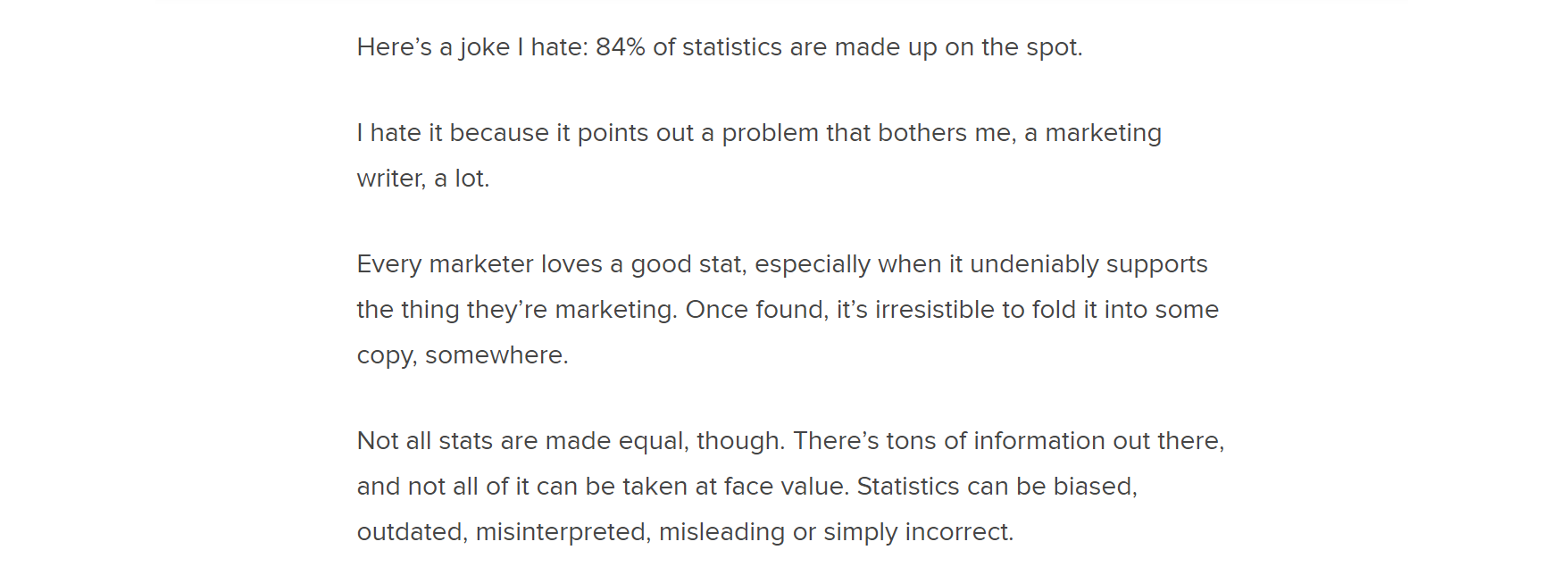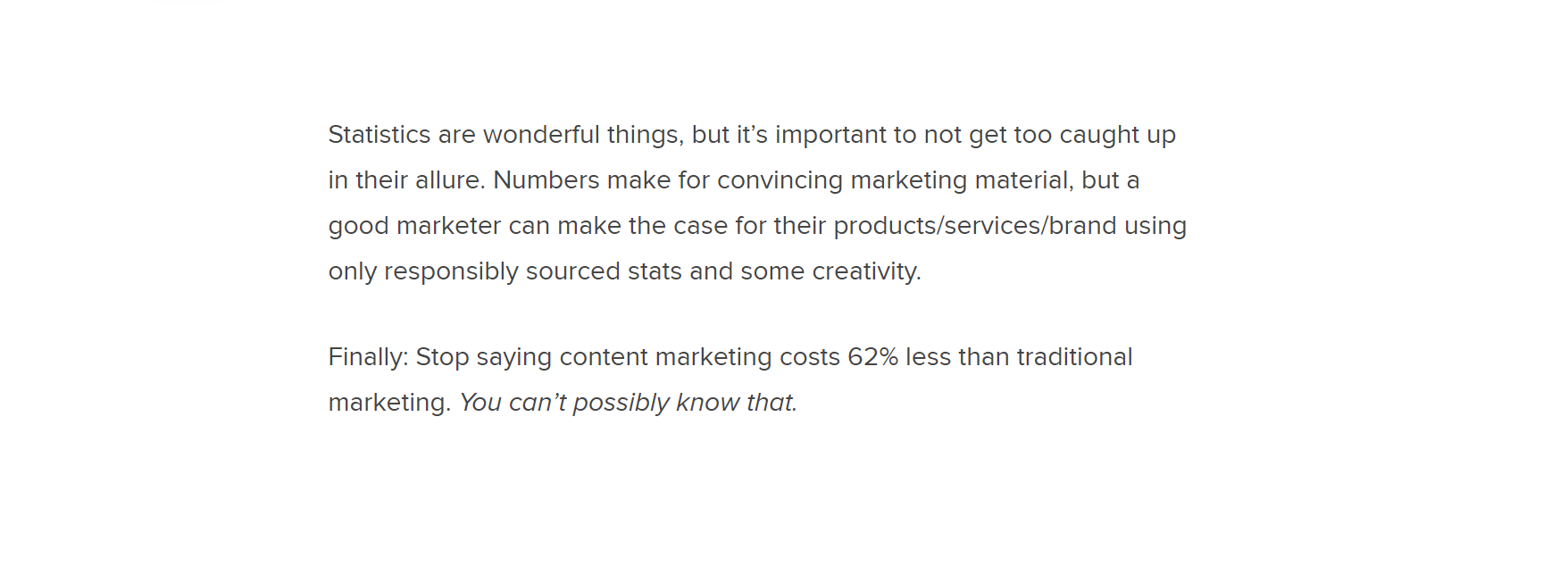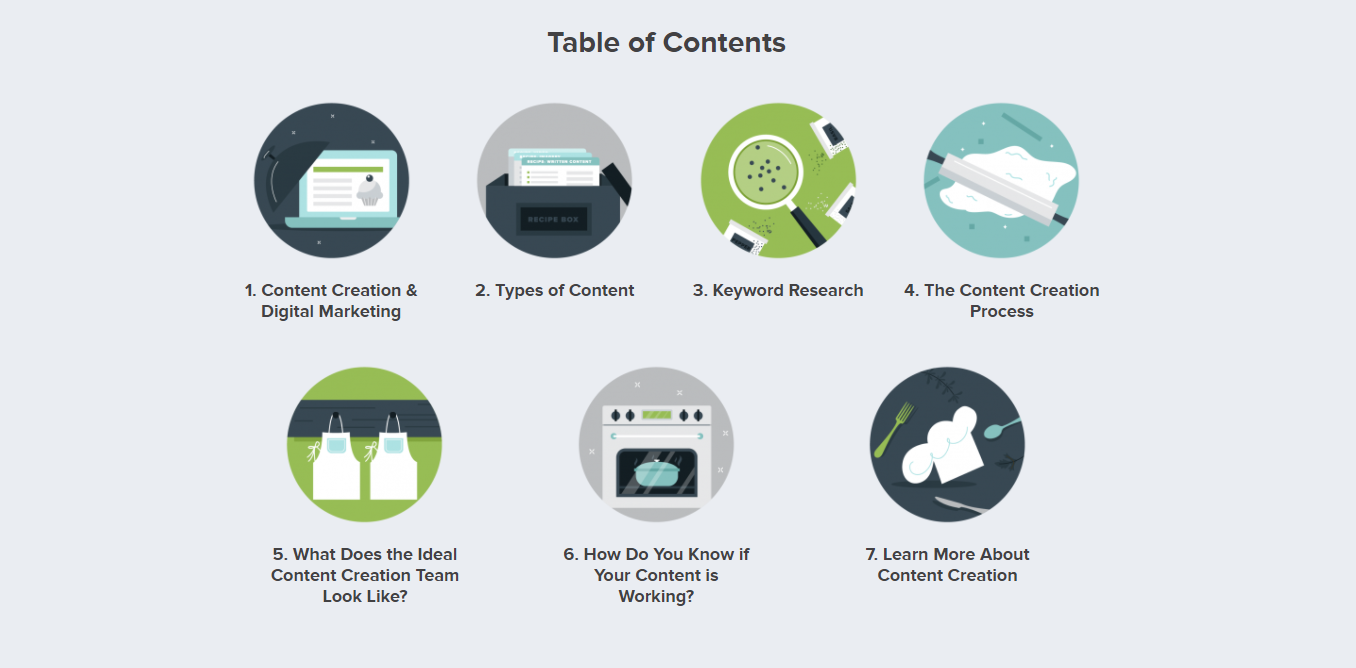How many blog posts do you think go out every day? A few thousand? Maybe somewhere close to 1 million?
Take a quick peek at Internet Live Stats — the average number of blogs posted actually hovers over 7 million. In fact, by the time you’ve finished this article, today’s tally will have grown by another 10,000.
Whoa, right?
It can feel like a challenge to write something that stands out in a crowd that large. Good news: You won’t have to reinvent the wheel to grab your readers’ attention. It all comes down to using the right mixture of post templates to give each piece of content its own “it factor.”
Without further ado, let’s go over 8 of the most popular types of blogs — and how you can use them to draw in your audience.
1. How-To Blogs and Step-by-Step Guides
How-to posts might as well be the reason the internet was invented in the first place — well, maybe don’t fact check on us on that, but you get what we’re saying.
Basically, how-to blogs and step-by-step guides are exactly what they sound like. The intent is to teach your audience how to do something new. As educational resources, these guides are a win for readers and bloggers alike. Your audience receives a valuable lesson on a topic they’re interested in, and you get to add to your stack of evergreen content.
Let’s use our own piece, How to Write a Newsletter, as our example of what a how-to article should look like.
The first step for writing your how-to blog? Picking a topic. Now, don’t get us wrong — the sky’s the limit when it comes to what you write about. However, for an educational piece like this, you should come with serious expertise. To zero in on your topic, ask yourself:
- Will this be a subject I can speak confidently on?
- Is there something valuable or different I can offer?
- What are the actionable steps my reader can take?
So, let’s go back to our example article. As a creative content marketing agency, we can definitely check off “writing tips” as one of our areas of expertise. Now, what about something valuable or different?
In our blog, we’ve included a colorful infographic that sums up the article and its takeaways. But if you don’t consider yourself the next digital Picasso, there are still several ways to put a new spin on an old topic aside from adding original graphics:
- Use examples: In our blog, we dissected a page from the Harvard Business Review’s website to help the reader understand the purpose of a newsletter.
- Tie in relevant statistics: Don’t feel like you need to stuff in data points wherever you can — just include the information where it makes sense. For our guide, that meant offering word count recommendations.
- Offer resources and next steps: Your reader should leave your blog confident enough to follow up on the information you provided. Just check the ending of our example post. Inspirational? Check. Resources to continue their learning? Double check.

2. Beginner’s Guides
If a step-by-step guide is teaching a reader how to do something new, a beginner’s guide is teaching them about something new.
In theory, the two sound pretty similar. But — pinky promise — there’s a slight and important difference. A how-to article is to homework as a beginner’s guide is to the entire 101 course. Rather than leaving the article knowing how to complete a task, the reader is armed with an all-encompassing primer on a new-to-them subject.
As you write a beginner’s guide of your own, keep these tips in mind:
- Keep it super simple: If you use any acronyms or industry jargon, be sure to explain them for your reader. The last thing you want is for your audience to feel like they’re missing something.
- Provide clear examples: Keep your definitions and descriptions as brief as possible. From there, tie in examples that illustrate the concept in practice.
- Put yourself in the reader’s shoes: Think about when you were first introduced to the subject. What were some of your burning questions? Which concepts did you find yourself Googling again and again?
To illustrate what all of that looks like, we’ll use another one of our own blog posts, The Essential B2B Digital Marketing Guide.

We open with a high-level overview of business-to-business (B2B) marketing — what it is, how it’s used and why the reader should care. After that, we dig into some specifics. This includes B2B marketing’s role in the sales process, industry trends and, finally, some real-world examples.
Think of it as taking the reader on a journey: From the early days of B2B marketing all the way through to the future of the industry, they get the full scoop. Strive to do the same in your own article.
Pro tip: Beginner’s guides not only position you as a thought leader in your industry, but they’ll also help raise brand awareness among new readers who weren’t even aware of your brand in the first place. While your reader may not be ready to lecture on the subject, they should feel far more familiar with it than they did when they first found your page.
3. Op-eds
Be real with us: When you open a physical copy of the newspaper, what’s the first thing you flip to? OK — after the cartoons? For many readers, there’s nothing more interesting than opening up the op-ed section and seeing what other people have to say.
An op-ed is short for “opposite the editorial page” as well as an acronym for the “opinions and editorials page.” This type of piece expresses the thoughts of the author. There’s no exact formula for writing an op-ed, but usually it will include an introduction on the topic and the author’s opinion followed by 2 or 3 supporting paragraphs chock full of evidence.
There’s one major keyword in that last sentence: evidence.
Providing proof to support your claim and walk the reader toward your final conclusion is the difference between writing a knowledgeable op-ed piece versus just shaking your fist at the sky.
Don’t feel as though you’re offending the reader by taking a side. By offering your own thoughts and backing them up with some concrete evidence, you’re providing a different type of value than you would by sitting firmly on the fence. Plus, developing a voice of your own is one of the most important aspects of writing an op-ed.
OK, but what if you don’t know what your voice sounds like? This tip for writing opinion-based articles from the Harvard Kennedy School should help: “A good method of perfecting your voice is to get in the habit of reading your column or op-ed out loud. Doing so gives you a clear sense of how your piece might sound – what your voice may come off as – to your intended reader.”
Let’s take a look at how one Brafton blogger shared her own voice in The Problem With Statistics in Blog Posts:

Immediately, you know who the writer is, why she’s a credible source and exactly where she stands on the topic. After hooking us with that powerful introduction, the article goes on to teach us about 5 of the most common statistic-based mistakes and tips to avoid falling victim to them ourselves.
Once we get to the conclusion, the author sums up her thoughts and ties it all together with a clear and memorable call back to the beginning of the piece:

At this point, the reader should have developed an opinion of their own on the subject. Including a concluding statement and a call to action ensures not only has your point been made, but that it’s also not one they’ll soon forget.
Our top 3 tips for op-eds?
- Maintain a clear voice.
- Weave in thematic statements throughout the piece.
- Always have evidence to support your claim.
Subscribe to
The Content Marketer
Get weekly insights, advice and opinions about all things digital marketing.
Thank you for subscribing to The Content Marketer!
4. Examples and Roundups
Example articles are the ultimate “show, don’t tell” type of blogging.
Like a lot of the blog post templates we’ve discussed, you probably have a good idea of what they are based on their name. The purpose of these posts is to round up examples that illustrate a specific point you’re making.
Let’s use The 13 Best Digital Marketing Examples from This Year (+ Takeaways) as our example for example posts.
The blogger first opens with a brief overview of what digital marketing is, giving the reader pointers on how to create a digital marketing strategy of their own. While you don’t have to start with an introduction on the topic, it’s a good way to give the reader context on the subject — especially if the goal of your piece is to provide them with inspiration.
From there, we dig into 13 innovative examples of digital marketing strategies at work.

What differentiates this article is that the writer takes things a step further. Not only do we learn about campaigns that range from Cashmere’s 19 Crimes partnership with Snoop Dogg to the modernized branding of the OG influencer Barbie, but we’re taught why they actually work.
As you search for your own examples, always think about why the reader should and will care about the cases you’ve picked out. In this article, the author is highlighting marketing strategies from the past year that all use innovative techniques to attract customers. There should be a clear theme and a connection to the overview if you provide one.
Is it just us, or are you also feeling a bit of an Inception moment reading about example articles … in an example article?
5. Pillar Posts
Pour yourself a cup of coffee and stretch out your wrists: It’s time for a pillar page.
A pillar page is a hub on which more focused articles, or clusters, are built. Think of a pillar as a sort of topic tree. It’s got foundational roots, can grow to be pretty large and has tons of small branches (clusters) coming off of it.
The purpose of a pillar is to provide a comprehensive overview of a topic — but it should also leave room for even more detailed coverage through your clusters. In your shorter cluster articles, you can go into more granular detail about your overarching subject.
By nature, pillars can get long. Usually, these pieces should hover around a minimum of 2,000 words. We use the word “should” because depending on your topic, your article may fall a little below that number or significantly above it. For example, one of our own pillar pages, What Is Content Creation? The Complete Guide, comes in at just over 4,000 words.
We know that word count can be a little daunting. Step 1: Take a breath — you’ve got this. Step 2: Try breaking down your pillar into smaller pieces:
- Pick your pillar subject: Keep your overarching topic pretty broad. If you have too narrow a focus, you might find yourself struggling to reach the comprehensive scope and length you need to draw traffic to your blog. For our page, we went with “content creation.”
- Identify some secondary keywords: Think about the types of clusters you can write based on your pillar. This will help guide the structure of your pillar page as well as some subtopics to include that leave room for your shorter pieces.
- Divide your pillar into sections: For our pillar, we have 7 unique sections that help to break up the page and make things a little more reader friendly. Plus, each section branches into 3 “Deep Dives” which serve as clusters on the subject.

Once you’ve written your pillar, your hard work will pay off. Not only do these longer pieces build up your topic authority and overall SEO ranking, but they also can be an especially helpful tactic when it comes to organizing and planning your content calendar. Once you’ve created your pillar page, you’ll already know what other related subtopics to write about. From there, your editorial calendar will build itself.
6. Industry Updates
Hot off the press and straight into your content strategy: Introducing industry updates.
Industry updates are different from standard news releases as they directly relate to major trends or changes in your own field of expertise. For example, an update we’ve written is What to Make (or Not Make) of Google’s May 2020 Core Update.
If you’re not sure whether a subject works as blog content, ask yourself the following questions:
Is It Newsworthy?
Determining this can be a little subjective. Chances are, if industry outlets are reporting on it, the topic likely is newsworthy. However, what matters most is whether your audience will care. Our post is directed toward marketers and those in the SEO community, so Google changing its ranking algorithm is a pretty big deal.
Can You Provide Value?
Don’t feel like you have to write an update just because others in your industry are. If you’re just rewording the same old news alert, you might be better off posting nothing at all. Instead, add value by providing your readers with actionable steps and your own expert insights.
In our Google update, the author provides data — and lots of it. Not only does he explain what’s going on in the world of SEO rankings, but he uses data that clearly shows a change has happened.
What comes next?
Your readers are looking for answers and clear recommendations. Providing clarity in a time of uncertainty can help to bolster your trustworthiness and build up your brand’s authority down the road.
The author of this post offers readers clear steps, contextualizing what the Google update means for their SEO strategy and how they can better position themselves amidst these changes.

Stay on top of changes in your industry by subscribing to newsletters, keeping up with social media and creating news alerts for certain phrases or keywords that your audience cares about. That way, you can be in the know and strike when the iron is hot.
7. Lists
A list post, commonly known as a listicle, is a form of content that uses a list as its thematic structure, but each section is fleshed out with enough content to be published as a complete article.
Not only are listicles ultra digestible for readers, but the ordered nature will help you to stay on track while you write. Just think of each bullet on your list as a mini article. It should have a clear purpose, an actionable conclusion and also tie into the rest of the sections in your piece.
Here you can see the topics we included in our own list-based article, 10 Content Writing Tips To Help You Get the Most Impact Out of Every Word.

Now, there are a lot of listicles out there. Some are quality, others … not so much. So what can you do to make sure yours falls into the former category?
- Provide context: We may be sounding like a bit of a broken record here, but context is important. Even just giving a brief overview can help the reader understand why they should care.
- Stay on theme: The topic of this article is “tips for impactful content writing.” Just by glancing at the table of contents, you can see how each section relates to that main blog post idea.
- Think like the reader: This bit of truth may hurt a little: Not every person will read your article from start to finish. Make sure each section of your listicle can stand on its own as a single post if someone were to only read that one piece.
In terms of how many items you need on your list, there’s really no perfect number. Don’t feel like you have to include a not-so-great section just to reach an even 10. In fact, sometimes just 8 will do the trick (wink wink).
8. Success Story
Everyone loves a good success story. So why not capitalize on your own?
Again, there’s no right way to create the perfect blog post. However, we recommend setting your success story up similar to how you would a case study. Introduce the situation, describe what changed and demonstrate the results.
Let’s see how all of those pieces can come together in the piece, Why You Need Infographics in Your Blog Posts.
The Situation
Opening the article with some background information will help give your reader some context as to why this is actually a success story in the first place.
In our example piece, the author clearly explains what the team set out to do: Determine the effectiveness of infographics as measured by backlinks.

What Changed
To figure out exactly how effective infographics were, the team got to work publishing about one a week to create a sort of live test environment.
Think of this as the solution section of a traditional case study. We’ve proposed a question or challenge, and now, we’re looking to get our answer.
The Results
Here is the part that can really make your success story shine. The more evidence and examples you can provide about the end result, the better. While our infographic piece lent itself to quantitative data, you can also use testimonials and stories to describe your win.
What actually constitutes using a success story for a new post? Well, that’s entirely up to you and your audience. Like any content, your subject matter should be relevant to your readers and provide some sort of actionable value. By illustrating our own success, readers walk away with a clear takeaway of their own: An infographic post will generate more results.
Picking the Right Blog Post Template
Remember: You don’t need to stick to a single post template, and you shouldn’t feel like you need to check the box on every one we discussed today. Let the topic you’re writing about guide you. Plus, having a clear blog content strategy will give you extra guidance whenever you sit down to write. Say goodbye to writer’s block and hello to new readers.





